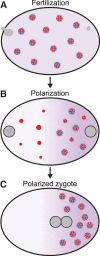RNA granules: functional compartments or incidental condensates?
- PMID: 37137715
- PMCID: PMC10270194
- DOI: 10.1101/gad.350518.123
RNA granules: functional compartments or incidental condensates?
Abstract
RNA granules are mesoscale assemblies that form in the absence of limiting membranes. RNA granules contain factors for RNA biogenesis and turnover and are often assumed to represent specialized compartments for RNA biochemistry. Recent evidence suggests that RNA granules assemble by phase separation of subsoluble ribonucleoprotein (RNP) complexes that partially demix from the cytoplasm or nucleoplasm. We explore the possibility that some RNA granules are nonessential condensation by-products that arise when RNP complexes exceed their solubility limit as a consequence of cellular activity, stress, or aging. We describe the use of evolutionary and mutational analyses and single-molecule techniques to distinguish functional RNA granules from "incidental condensates."
Keywords: RNA granules; condensates; phase separation; ribonucleoprotein complexes.
© 2023 Putnam et al.; Published by Cold Spring Harbor Laboratory Press.
Figures



References
Publication types
MeSH terms
Substances
Grants and funding
LinkOut - more resources
Full Text Sources
